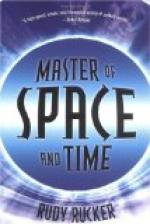Early one morning a woman was found dead in her home in the suburbs of London. A man had been observed leaving the house, and his appearance had been noted. Inquiries revealed that a man answering his description had left on the slow train for London. Without the telegraph he could not have been apprehended. But the telegraph was available at this point, and his description was telegraphed ahead and the police in London were instructed to arrest him upon his arrival. “He is dressed as a Quaker,” ran the message. There was no Q in the alphabet of-the five-needle instrument, and so the sender spelled Quaker, Kwaker. The clerk at the receiving end could not-understand the strange word, and asked to have it repeated again and again. Finally some one suggested that the message be completed and the whole was then deciphered. When the man dressed as a Quaker stepped from the slow train on his arrival at London the police were awaiting him; he was arrested and eventually confessed the murder. The news of this capture and the part the telegraph played gave striking proof of the utility of the new invention, and public skepticism and indifference were overcome.
By 1845 Wheatstone had so improved his apparatus that but one wire was required. The single-needle instrument pointed out the letters on the dial around it by successive deflections in which it was arranged to move, step by step, at the will of the sending station. The single-needle instrument, though generally displaced by Morse’s telegraph, remained in use for a long time on some English lines. Wheatstone had also invented a type-printing telegraph, which he patented in 1841. This required two circuits.
With a working telegraph attained, the partners became involved in an altercation as to which deserved the honor of inventing the same. The quarrel was finally submitted to two famous scientists for arbitration. They reported that the telegraph was the result of their joint labors. To Wheatstone belongs the credit for devising the apparatus; to Cooke for introducing it and placing it before the public in working form. Here we see the combination of the man of science and the man of business, each contributing needed talents for the establishment of a great invention on a working basis.
Wheatstone’s researches in the field of electricity were constant. In 1840 he devised a magnetic clock and proposed a plan by which many clocks, located at different points, could be set at regular intervals with the aid of electricity. Such a system was the forerunner of the electrically wound and regulated clocks with which we are now so familiar. He also devised a method for measuring the resistance which wires offer to the passage of an electric current. This is known as Wheatstone’s bridge and is still in use in every electrical and physical laboratory. He also invented a sound telegraph by which signals were transmitted by the strokes of a bell operated by the current at the receiving end of the circuit.




